The AMD Ryzen 7 5700G, Ryzen 5 5600G, and Ryzen 3 5300G Review
by Dr. Ian Cutress on August 4, 2021 1:45 PM ESTMicrobenchmarks
Core-to-Core Latency
As the core count of modern CPUs is growing, we are reaching a time when the time to access each core from a different core is no longer a constant. Even before the advent of heterogeneous SoC designs, processors built on large rings or meshes can have different latencies to access the nearest core compared to the furthest core. This rings true, especially in multi-socket server environments.
But modern CPUs, even desktop and consumer CPUs, can have variable access latency to get to another core. For example, in the first-generation Threadripper CPUs, we had four chips on the package, each with 8 threads, and each with a different core-to-core latency depending on if it was on-die or off-die. This gets more complex with products like Lakefield, which has two different communication buses depending on which core is talking to which.
If you are a regular reader of AnandTech’s CPU reviews, you will recognize our Core-to-Core latency test. It’s a great way to show exactly how groups of cores are laid out on the silicon. This is a custom in-house test built by Andrei, and we know there are competing tests out there, but we feel ours is the most accurate to how quick an access between two cores can happen.
The Ryzen 7 5700G has the quickest thread-to-thread latency, however does offer a single slowest core-to-core latency. But compared to the 4000G series, having a single unified L3 cache reduces to core-to-core latency a good amount. The Ryzen 5 5300G has the slowest intracore latency, but the fastest average core-to-core.
Per-Core Power
One other angle to examine is how much power each core is drawing with respect to the rest of the chip. In this test, we run POV-Ray with a specific thread mask for a minute, and take a power reading 30 seconds into the test. We output the core power values from all cores, and compare them to the reported total package power.
The peak per-core power is shown as 15.2 W when one core is loaded on the Ryzen 7 5700G, and that comes down to ~8.8W when all cores are loaded. Interestingly this processor uses more power when six cores are loaded.
The Ryzen 5 5300G starts at 11.5 W for a single core, but then moves up to 12.3 W when three cores are loaded. It comes back down to 11.5 W when all four cores are loaded, but this ensures a consistent frequency (the 5300G has a 4.2 GHz Base and 4.4 GHz Turbo, explaining the small variation in loading).
Frequency Ramping
Both AMD and Intel over the past few years have introduced features to their processors that speed up the time from when a CPU moves from idle into a high-powered state. The effect of this means that users can get peak performance quicker, but the biggest knock-on effect for this is with battery life in mobile devices, especially if a system can turbo up quick and turbo down quick, ensuring that it stays in the lowest and most efficient power state for as long as possible.
Intel’s technology is called SpeedShift, although SpeedShift was not enabled until Skylake.
One of the issues though with this technology is that sometimes the adjustments in frequency can be so fast, the software cannot detect them. If the frequency is changing on the order of microseconds, but your software is only probing frequency in milliseconds (or seconds), then quick changes will be missed. Not only that, as an observer probing the frequency, you could be affecting the actual turbo performance. When the CPU is changing frequency, it essentially has to pause all compute while it aligns the frequency rate of the whole core.
We wrote an extensive review analysis piece on this, called ‘Reaching for Turbo: Aligning Perception with AMD’s Frequency Metrics’, due to an issue where users were not observing the peak turbo speeds for AMD’s processors.
We got around the issue by making the frequency probing the workload causing the turbo. The software is able to detect frequency adjustments on a microsecond scale, so we can see how well a system can get to those boost frequencies. Our Frequency Ramp tool has already been in use in a number of reviews.
In our test, the Ryzen 5 5600G jumps from 2700 to the turbo frequency in around a millisecond.


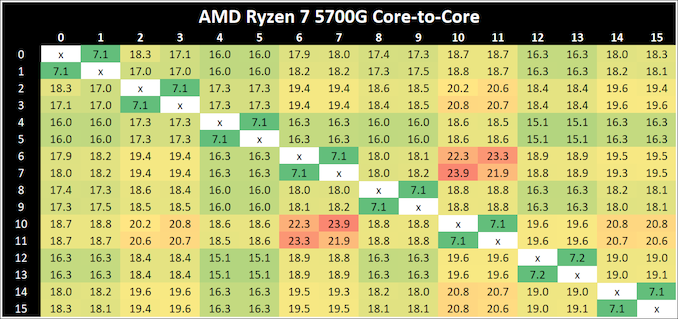
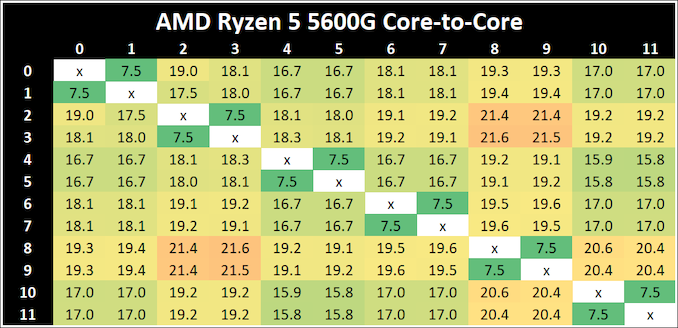
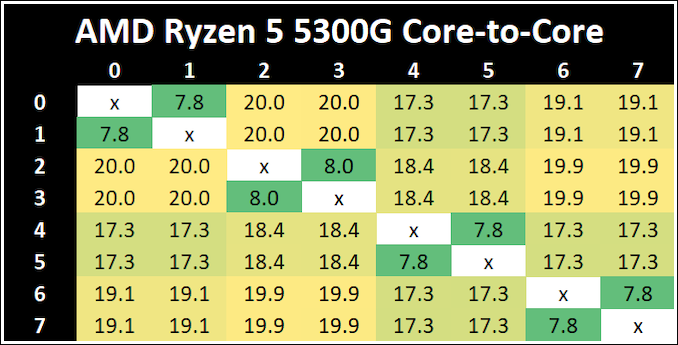
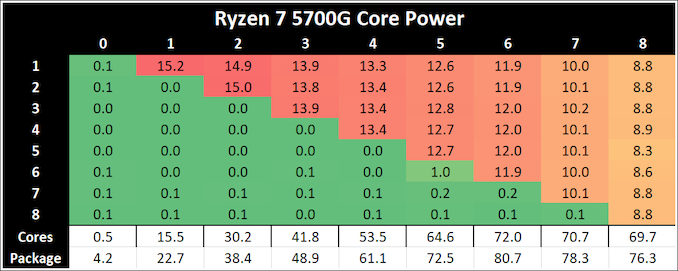
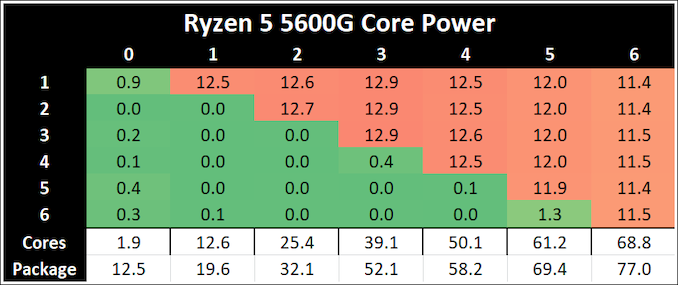
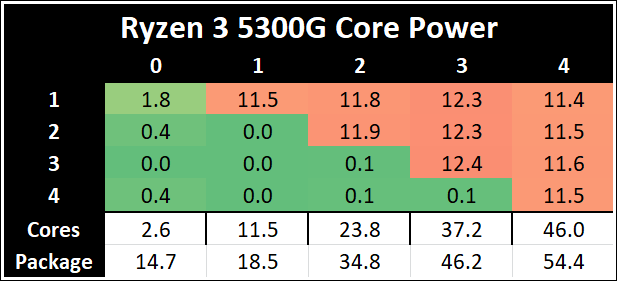
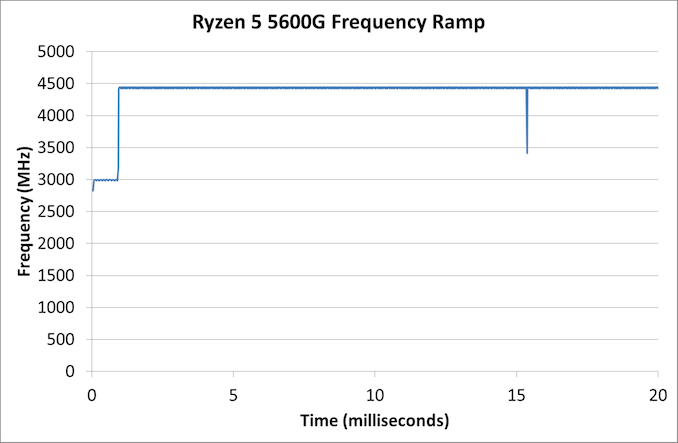








135 Comments
View All Comments
Dribble - Friday, August 6, 2021 - link
Might be because it isn't as power limited and hence won't throttle in the same way the AMD chip.Danvelopment - Thursday, August 5, 2021 - link
Is the 5600G 6 core or 8 core? The first page of the article says it's both on the two tables.eastcoast_pete - Thursday, August 5, 2021 - link
Now, imagine if those 5700 APUs would have kept the core numbers of the 3400, but clocked at current speeds. I hope that Intel will bring its 10 nm Desktop CPUs with the full Xe compliment of mobile Tiger Lake, as that might force AMD to up its game; well, the next APU generation will be RDNA2, so as long as AMD doesn't gimp it by keeping the GPU tiny, it should have significant uplift over CézanneCooe - Friday, August 6, 2021 - link
Far Cry 5 running at ≈25fps on average at "1080p Ultra" is actually CRAZY freaking impressive. Why? Because that means it should hit a solid >=30fps running at "1080p High", which basically means that this single chip APU solution is outperforming BOTH of the last generation console base models (aka PS4 & Xbox One/S) in this title!!! That's freaking NUTS!!!nandnandnand - Tuesday, August 10, 2021 - link
I wouldn't be surprised to see 1080p60 in the same scenarios with Rembrandt next year. But DDR5 will be expensive.nanonan - Friday, August 6, 2021 - link
Every other source I've read states the pcie configuration as 24 lanes divided into 16, 4 and 4 just like the 4000G series. Do you have a source for this 8+4+8 configuration?linuxgeex - Friday, August 6, 2021 - link
Anand wasn't perfect with proofing either but he was thorough on deep dives, exposing bottlenecks and explaining how and why it was relevant. These days Ian and co assume that if we're Anandtech readers we just trust their methodology and do some lip service by adding cut&paste boilerplate around specs and throw in an image sometimes from a past review, sometimes not directly relevant, and I get that they only have so much time to invest. It bores me, and it doesn't give the new people the same level of engagement that will built their future audience. Oh welles.Samus - Friday, August 6, 2021 - link
I blacked out after getting to the part where an entry-level AMD APU starts at $259.While I get yes there are the Athlon's, they are mostly outclassed by a 9th gen $90 Intel Core i3 so it isn't even worth consideration.
GeoffreyA - Saturday, August 7, 2021 - link
Yes, pricing is disappointing.mode_13h - Sunday, August 8, 2021 - link
They're starting strong, because it's a lot easier to lower prices than raise them, and that pricing reflects the supply/demand situation, especially when the 3000-gen are still widely available.Over time, I'm sure you can expect to see the gap close, particularly since the process node is the same and die sizes are similar.